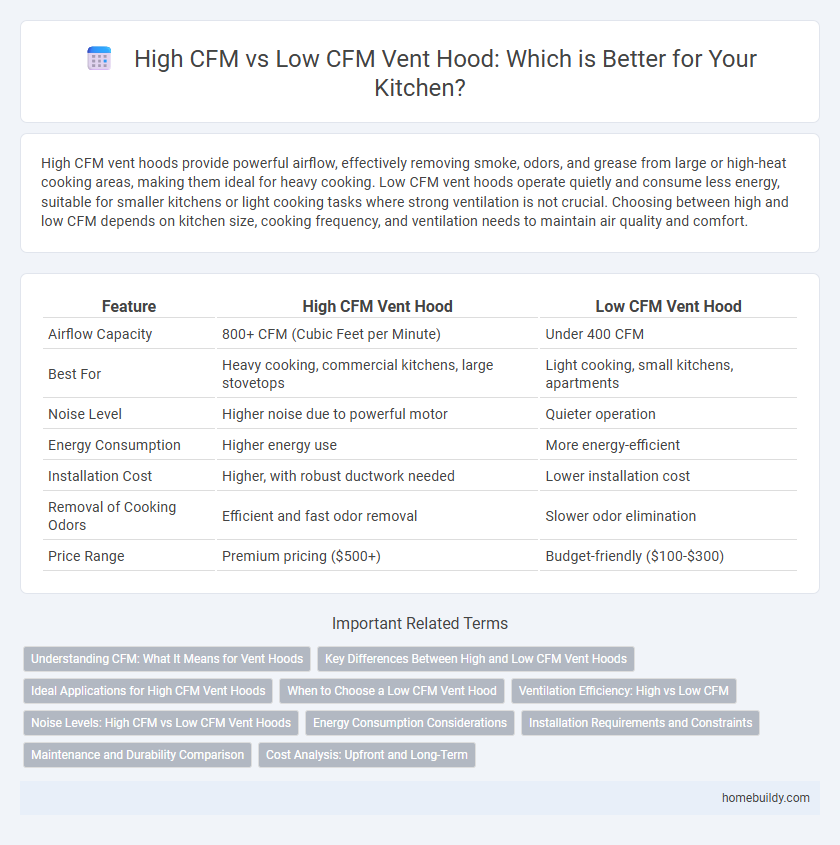High CFM vent hoods provide powerful airflow, effectively removing smoke, odors, and grease from large or high-heat cooking areas, making them ideal for heavy cooking. Low CFM vent hoods operate quietly and consume less energy, suitable for smaller kitchens or light cooking tasks where strong ventilation is not crucial. Choosing between high and low CFM depends on kitchen size, cooking frequency, and ventilation needs to maintain air quality and comfort.
Table of Comparison
| Feature | High CFM Vent Hood | Low CFM Vent Hood |
|---|---|---|
| Airflow Capacity | 800+ CFM (Cubic Feet per Minute) | Under 400 CFM |
| Best For | Heavy cooking, commercial kitchens, large stovetops | Light cooking, small kitchens, apartments |
| Noise Level | Higher noise due to powerful motor | Quieter operation |
| Energy Consumption | Higher energy use | More energy-efficient |
| Installation Cost | Higher, with robust ductwork needed | Lower installation cost |
| Removal of Cooking Odors | Efficient and fast odor removal | Slower odor elimination |
| Price Range | Premium pricing ($500+) | Budget-friendly ($100-$300) |
Understanding CFM: What It Means for Vent Hoods
CFM (cubic feet per minute) measures the airflow capacity of vent hoods, indicating how much air the hood can move per minute. High CFM vent hoods efficiently remove smoke, odors, and grease from large kitchens or heavy cooking, preventing air contamination and buildup. Low CFM vent hoods suit smaller kitchens or light cooking needs, consuming less energy while maintaining adequate ventilation.
Key Differences Between High and Low CFM Vent Hoods
High CFM vent hoods deliver greater airflow, measured in cubic feet per minute, making them ideal for heavy cooking that produces intense smoke, steam, or odors. Low CFM vent hoods operate at lower airflow rates, offering quieter performance and energy efficiency suited for lighter cooking environments or smaller kitchens. Key differences lie in their ventilation capacity, noise levels, and power consumption, impacting overall kitchen air quality and comfort.
Ideal Applications for High CFM Vent Hoods
High CFM vent hoods, typically ranging from 600 to 1200 cubic feet per minute, are ideal for kitchens with high-heat cooking appliances such as gas ranges, grills, and fryers. These vent hoods efficiently remove smoke, grease, and strong odors, improving indoor air quality in commercial kitchens or large residential cooking spaces. Optimal installation includes spaces where heavy cooking generates substantial airborne contaminants requiring robust ventilation to prevent accumulation and maintain safety.
When to Choose a Low CFM Vent Hood
A low CFM vent hood is ideal for kitchens with limited cooking activities or smaller stovetops, as it provides adequate ventilation without excessive noise or energy use. Selecting a low CFM vent hood is beneficial in well-ventilated spaces where strong airflow is unnecessary, helping to maintain indoor air quality efficiently. It also suits apartments or homes with ducting restrictions where high airflow could cause backdrafts or ventilation imbalance.
Ventilation Efficiency: High vs Low CFM
A high CFM vent hood offers superior ventilation efficiency by rapidly removing smoke, odors, and airborne grease, making it essential for heavy cooking environments. Low CFM vent hoods provide adequate ventilation for light to moderate cooking but may struggle with high heat and large smoke volumes, leading to slower air clearance. Choosing the correct CFM based on kitchen size and cooking intensity optimizes air quality and prevents grease buildup.
Noise Levels: High CFM vs Low CFM Vent Hoods
High CFM vent hoods generally produce higher noise levels due to increased airflow and motor power, often exceeding 70 decibels, which can disrupt kitchen environments. Low CFM vent hoods operate more quietly, typically generating noise around 40 to 50 decibels, making them suitable for open-concept spaces where noise reduction is essential. Selecting the appropriate vent hood depends on balancing ventilation efficiency with acceptable noise output for user comfort.
Energy Consumption Considerations
High CFM vent hoods provide powerful ventilation but consume significantly more energy compared to low CFM models, impacting overall utility costs. Low CFM vent hoods offer energy-efficient operation by using less airflow while still maintaining adequate kitchen ventilation for most residential needs. Selecting the appropriate CFM level balances effective smoke and odor removal with minimizing electricity usage, optimizing energy consumption without sacrificing performance.
Installation Requirements and Constraints
High CFM vent hoods require larger ductwork and more powerful exhaust fans, leading to increased installation complexity and higher costs. They often necessitate robust structural support and more extensive electrical wiring to handle increased power demands. In contrast, low CFM vent hoods have simpler installation requirements, can utilize smaller ducts, and are suitable for homes with limited space or existing venting infrastructure.
Maintenance and Durability Comparison
High CFM vent hoods typically require more frequent maintenance due to increased air volume and potential grease buildup, necessitating regular filter cleaning and duct inspections to maintain peak performance. Low CFM vent hoods generally offer easier maintenance with less strain on components, often resulting in longer-lasting parts and lower overall wear. Durability of high CFM hoods is challenged by continuous heavy use, while low CFM models tend to sustain longevity through gentler operational demands.
Cost Analysis: Upfront and Long-Term
High CFM vent hoods typically have a higher upfront cost due to more powerful motors and advanced filtration systems, but they offer greater efficiency in removing smoke and odors, potentially reducing maintenance expenses over time. Low CFM vent hoods generally cost less initially but may lead to increased energy consumption and more frequent filter replacements, resulting in higher long-term costs. Evaluating both upfront investment and ongoing operational expenses is crucial for selecting the most cost-effective vent hood for kitchen ventilation needs.
High CFM vent hood vs Low CFM vent hood Infographic

 homebuildy.com
homebuildy.com